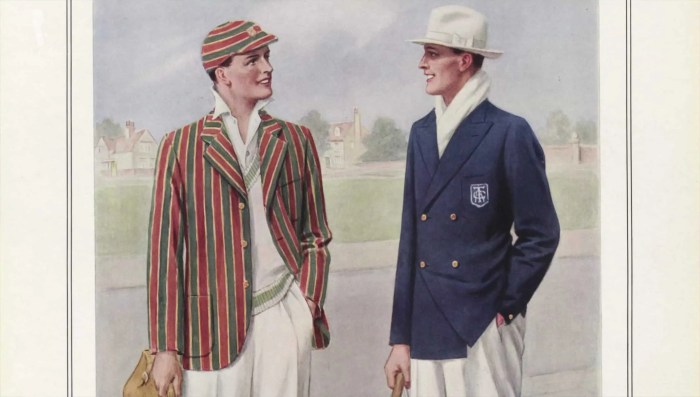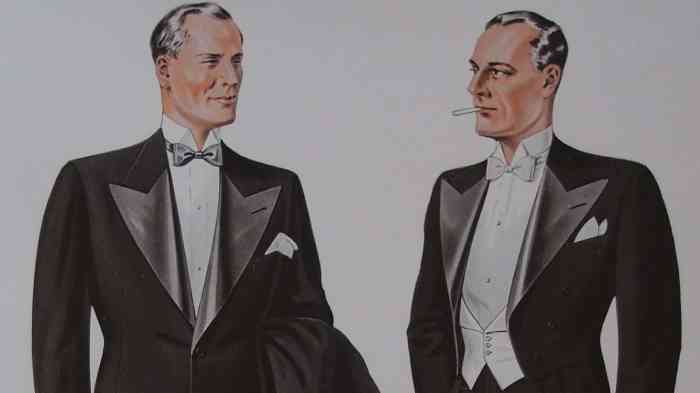The Rise of the Modern Man
Men’s fashion from the 1920s – The 1920s witnessed a dramatic shift in men’s fashion, reflecting broader societal changes that swept across the Western world. The era, often romanticized as the “Roaring Twenties,” was characterized by rapid industrialization, increased urbanization, and a burgeoning sense of youthful rebellion against the more formal traditions of the preceding Edwardian era. These societal shifts profoundly impacted how men presented themselves, leading to a revolution in menswear.The post-World War I landscape fostered a spirit of modernity and a rejection of the stuffy formality of Victorian and Edwardian styles.
Men, having experienced the trauma and upheaval of war, sought a more relaxed and expressive approach to their clothing. This desire for comfort and self-expression, coupled with advancements in textile manufacturing and design, resulted in a significant departure from the previous generation’s sartorial choices.
Changes in Silhouette and Fabric
The restrictive, heavily structured suits of the Edwardian era gave way to a more relaxed silhouette. High, stiff collars softened, jackets became less structured and more comfortable, and trousers became looser and often featured a lower waistline. The introduction of new fabrics, like lighter weight wool and rayon, contributed to this shift toward greater comfort and ease of movement.
The wide-legged, high-waisted trousers of the earlier period were replaced by slimmer, lower-slung styles that offered a more streamlined appearance. The overall effect was a move away from the rigid formality of the past towards a more casual, yet stylish, look.
The Influence of Hollywood and Popular Culture
Hollywood played a pivotal role in shaping men’s fashion trends of the 1920s. Film stars like Rudolph Valentino, with his impeccably tailored suits and dashing demeanor, became style icons, influencing the way men dressed. Their on-screen personas, often portraying sophisticated and rebellious characters, helped popularize the new, more relaxed styles. Moreover, the rise of mass media, including magazines and newspapers dedicated to fashion, ensured that these trends quickly spread beyond the silver screen, reaching a wider audience and solidifying their influence.
This created a feedback loop where popular culture both reflected and shaped men’s fashion choices. For example, the popularity of sports like golf and tennis contributed to the adoption of more casual sportswear elements into everyday attire.
A Comparison with Edwardian Style
In contrast to the Edwardian era’s emphasis on formality and stiffness, the 1920s saw a marked shift towards comfort and individuality. Edwardian men favored tightly fitted suits with high-collared shirts, waistcoats, and formal accessories. Their clothing was often made from heavy fabrics and featured intricate detailing. The 1920s, conversely, embraced a looser, more relaxed style. Suits remained a staple, but they were less constricting, often featuring softer shoulders and a more natural drape.
The use of lighter fabrics and simpler designs reflected a preference for ease and comfort over elaborate formality. The overall impression was one of a more youthful and dynamic aesthetic, a significant departure from the restrained elegance of the Edwardian era. The difference was stark; a transition from a formal, almost severe style to a more relaxed, almost nonchalant style.
Key Garments and Accessories of the Era

The 1920s witnessed a significant shift in men’s fashion, moving away from the more formal styles of the Edwardian era towards a more relaxed and streamlined aesthetic. This evolution was reflected in both the garments themselves and the accessories that complemented them, creating a distinctly modern look that continues to influence menswear today. The decade saw the rise of new silhouettes and fabrics, reflecting the changing social landscape and the burgeoning prosperity of the time.
Key Garments and Their Characteristics, Men’s fashion from the 1920s
The following table details some of the essential garments of 1920s menswear, highlighting their construction and defining features.
| Garment | Description | Materials Used | Notable Features |
|---|---|---|---|
| Suit | The cornerstone of the 1920s wardrobe, typically consisting of a jacket and trousers. | Wool (worsted and flannel were popular), tweed, gabardine. | High-waisted trousers, often with a slight flare at the bottom; single-breasted jackets with a slightly shorter length; notched lapels. |
| Overcoat | A versatile outer garment worn for warmth and protection. | Wool, cashmere, cheviot. | Often featured a belted waist, raglan sleeves, or a boxy silhouette. Length varied depending on the style. |
| Hat | An essential accessory for men, signifying social status and personal style. | Felt (for fedoras and homburgs), straw (for summer wear). | Fedoras, homburgs, bowler hats were common choices. The brim width and crown height varied depending on the hat style. |
| Shirt | Worn under the suit jacket, usually with a collar and cuffs. | Cotton, linen. | Often featured a high collar, sometimes with a detachable collar band. Plain white shirts were preferred for formal occasions. |
| Trousers | Paired with a suit jacket or worn separately. | Wool, flannel, gabardine. | High-waisted, often with a slight flare at the ankle, and typically worn with suspenders or braces. |
Visual Representation of a Typical 1920s Outfit
Imagine a man dressed in a charcoal grey worsted wool suit. The jacket is single-breasted with notched lapels, falling just below the waist. His high-waisted trousers are neatly pressed and have a slight flare at the ankle, held up by dark brown leather suspenders. A crisp white cotton shirt with a high collar is visible at the neck, peeking out from under a subtly patterned silk tie in muted tones of burgundy and grey.
He wears a black felt fedora with a medium-width brim, tilted slightly to one side. A neatly folded pocket square, perhaps in a contrasting color or pattern, adds a touch of sophistication to his breast pocket. Finally, polished black leather oxfords complete the ensemble.
The Significance of Accessories
Accessories played a crucial role in defining a man’s style and social standing in the 1920s. The hat, for instance, was a powerful indicator of both social class and personal taste. A fedora, for example, could convey a sense of sophistication and modernity, while a bowler hat might suggest a more conservative or business-oriented individual. Pocket squares, often overlooked today, were essential for adding a subtle yet impactful element of personal expression.
Carefully chosen ties, reflecting both color and pattern, served to complement the overall outfit and express individual taste. The selection of these accessories, in conjunction with the overall attire, contributed significantly to projecting a desired image.
Evolution of Suit Styles During the 1920s
The 1920s saw a clear shift in suit styles, moving away from the fuller, more structured shapes of the preceding era. The decade’s suits were characterized by a slimmer, more streamlined silhouette. Jackets became shorter and more fitted, with narrower lapels and a more natural shoulder line. Trousers also became slimmer, often with a slight taper or flare at the bottom, abandoning the fuller, baggier styles of the earlier years.
Men’s fashion in the 1920s saw a shift towards looser, more comfortable styles, a departure from the previous era’s formality. This relaxed approach is interesting to compare with the more refined, yet still stylish, kentucky derby mens fashion , which often incorporates elements of classic tailoring. The influence of the Roaring Twenties can still be observed in some modern Derby attire, showcasing the enduring appeal of those early 20th-century designs.
The fabrics used also reflected this change, with lighter weight woolens and smoother gabardines becoming increasingly popular, reflecting the more relaxed and informal atmosphere of the era. This evolution mirrored the broader cultural changes occurring, reflecting the era’s newfound emphasis on modernity, comfort, and a more relaxed social demeanor.
The Legacy of 1920s Men’s Fashion: Men’s Fashion From The 1920s

The sartorial revolution of the 1920s left an indelible mark on menswear, influencing styles for generations to come. The era’s embrace of a more relaxed silhouette and streamlined aesthetic continues to resonate in contemporary fashion, proving that classic style transcends time. Its impact is evident not only in direct revivals but also in the subtle undercurrents that shape modern design choices.The relaxed yet sophisticated lines of 1920s menswear profoundly impacted subsequent decades.
The shift away from the more restrictive styles of the Victorian and Edwardian eras established a foundation for the more casual yet refined look that continues to be popular. This influence can be seen in the enduring appeal of tailored suits with a slimmer fit, the prevalence of comfortable yet stylish sportswear, and the continued popularity of accessories like fedoras and pocket squares.
The 1920s established a balance between formality and comfort that remains a cornerstone of modern men’s style.
The Revival and Reinterpretation of 1920s Style in Modern Menswear
Elements of 1920s style have been consistently revived and reinterpreted throughout the decades. The slim-fitting suit, a hallmark of the era, has experienced numerous comebacks, often updated with modern fabrics and details. The iconic pinstripe suit, for example, remains a staple in contemporary menswear, albeit sometimes with a more contemporary cut or color palette. Similarly, the relaxed yet elegant lines of 1920s sportswear, such as knickerbockers and plus-fours, have inspired modern athletic-leisure styles.
These revivals often maintain the core aesthetic of the 1920s while incorporating contemporary sensibilities. For example, modern interpretations of the era’s characteristic double-breasted jackets often feature more streamlined silhouettes and updated fabrics.
The Influence of 1920s Aesthetics on Contemporary Designers and Trends
The aesthetic of the 1920s continues to inspire contemporary designers, subtly shaping current trends. The clean lines, geometric patterns, and emphasis on quality craftsmanship resonate strongly in modern collections. Many designers draw inspiration from the era’s Art Deco movement, incorporating its geometric motifs and luxurious materials into their designs. This is evident in the use of bold colors, geometric patterns, and luxurious fabrics in modern menswear.
The emphasis on well-tailored garments and the attention to detail characteristic of 1920s style continues to influence the work of contemporary designers seeking to create timeless and sophisticated pieces. The subtle elegance and understated sophistication of the era remains a potent force in shaping modern fashion sensibilities.
Query Resolution
What were common hairstyles for men in the 1920s?
Short, neatly groomed hair was prevalent, often parted on the side or slicked back. The “slicked-back” look was particularly popular.
Were there any specific brands or designers popular during the 1920s?
While mass-produced clothing was becoming more common, bespoke tailoring remained prestigious. Specific brands aren’t as readily identifiable as in later decades, but high-end tailors in major cities held significant influence.
How did the economic climate impact men’s fashion choices?
The post-war economic boom increased the availability and affordability of fashionable clothing for a wider range of men, leading to a greater adoption of stylish garments.
What were some common footwear styles?
Oxfords, brogues, and spats were popular footwear choices, reflecting both formality and practicality.
